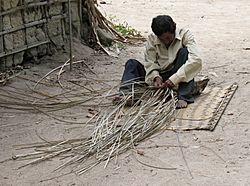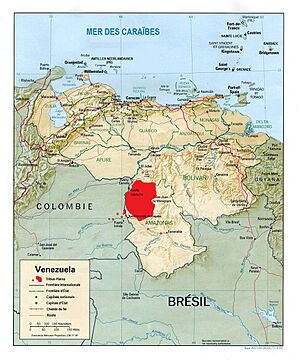Piaroa people facts for kids
| Huottüja, De'aruhua | |
|---|---|
|
Huottüja man making a sebucan.
|
|
| Total population | |
| 14,494 | |
| Regions with significant populations | |
| Languages | |
| Piaroa, Maquiritare, Yabarana, and Spanish | |
| Religion | |
| Indigenous, Shamanism, Christianity | |
| Related ethnic groups | |
| Maku |
The Piaroa people, also known as the Huottüja or De'aruhua, are an indigenous group from South America. They lived in the Orinoco River Basin long before Europeans arrived. Today, they live in parts of Colombia and Venezuela. Their territory is very large, bigger than the country of Belgium!
About 15,000 Piaroa people live in this area. Around 2,500 of them live in Colombia, in special areas called reservations. Since they were first met by outsiders around 1780, the Piaroa have lived peacefully. They have many small villages, each with its own leaders. They believe in working together and being fair to everyone.
In recent years, the Piaroa have worked to protect their culture and land. They have chosen official leaders and created special laws. These laws help protect their environment and their way of life. They have also mapped their villages, rivers, and important places in their own language and in Spanish.
Contents
Who are the Piaroa?
The name "Piaroa" is what others call them. The people themselves prefer to be called "Huottüja". This name means "knowledgeable people of the forest." Some men are also known as "De'aruwa" or "De'aruhua," meaning "masters of the forest."
Piaroa Territory
The Piaroa have declared their land as their own special territory. This happened in 2020, using laws that protect indigenous people in Venezuela, Colombia, and the United Nations. Their original land covers about 33,000 square kilometers.
The Piaroa have faced challenges from groups who try to take their land for illegal mining or other activities. Because the government has not always protected them, the Piaroa have created their own government body. This helps them defend their homes, families, and the natural environment.
How Piaroa Society Works
The Piaroa believe that competition is bad. They value cooperation and fairness. Each community leads itself, and they often work together. They do not like people who try to control others or gather too many things for themselves. They believe this can limit people's freedom.
The Huottüja value humility, peace, and good morals. They usually marry one person and rarely separate. While some old stories describe them as very peaceful, modern researchers say they sometimes had conflicts with nearby groups. These conflicts were often about important resources, like special clay for making pottery.
Leaders in Piaroa society are usually men, but women also have a lot of influence. Everyone is seen as equal. Because each community makes its own decisions and there is no single ruler, some people describe the Piaroa as a society that works without a central government.
Piaroa Beliefs and Religion
The traditional Piaroa religion involves shamans and focuses on a creator god named Wahari. Wahari was believed to have taken the form of a tapir, a large animal found in South America.
Over time, different Christian missionaries came to the Piaroa lands. Many Piaroa people have become Christians. However, about half of the Piaroa still follow their traditional beliefs. Even Christian Piaroa support their original culture, language, and traditions, including shamanism and their old stories. They see themselves as Huottüja first, no matter their religion.
Piaroa Economy and Work
The Piaroa mostly grow their own food. They also fish, gather fruits, and hunt small animals. They do not usually sell these things. However, they do sell some fish and fruits to earn money.
Since the 1980s, the Piaroa have started growing special plants like cocoa and other native crops to sell. Some also raise cattle, make baskets, or collect vines for furniture. Many Piaroa also work in different jobs to earn a salary.
The cocoa grown by the Piaroa has become famous around the world. Chocolate makers in different countries use it to make special chocolates. Many Piaroa villages deep in the forest now grow organic cocoa.
For a while, ecotourism was important for the Piaroa economy. This meant people visited their communities to learn about their culture and nature. However, due to problems in Venezuela, tourism has greatly decreased.
Piaroa Language
The Piaroa speak a language called Wötʰïhä tivene, or Piaroa language. It is part of the Saliban language family. For a long time, their language was mostly spoken, not written.
In the 1950s, a group called the Summer Institute of Linguistics helped create an alphabet for the Piaroa language. Since then, the Piaroa have developed their own alphabet, a basic dictionary, and school books for children.
Images for kids
See also
 In Spanish: Piaroas para niños
In Spanish: Piaroas para niños







